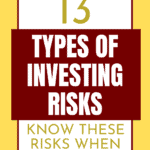THIS POST MAY CONTAIN AFFILIATE LINKS. PLEASE SEE MY DISCLOSURES. FOR MORE INFORMATION.
No matter how much research you do before investing, there are always a degree of risk involved.
Most investors assume the only risk they face when investing their money is the potential loss of principal.
But there are many other investing risks besides the risk of losing money.
In fact, you can never know for sure what will happen with the market or if your investment will be profitable.
In this post, I cover 13 of the types of investing risk you will face.
It is important to know these investment risks so you can make the best decisions for your financial situation and financial goals.
Table of Contents
13 Types Of Investing Risks
Systematic Risk vs. Unsystematic Risk
Before we talk about all the various investing risks you face as an investor, you need to understand two important types of risks.
Systematic risk is the overall risk of the market as a whole.
On any day, something could happen and the market can collapse.
You accept this risk by investing.
It cannot be controlled.
Unsystematic risk is industry or firm specific risk you expose yourself to when you are investing.
The good news with unsystematic risk is you can control this to a degree.
This is mainly done by diversifying your money.
Many times unsystematic risk is called residual risk, specific risk, or diversifiable risk.
In either case, you cannot avoid these risks.
All of the types of risk listed below are part of systematic or unsystematic risk.
As a result, some can be controlled, while others cannot.
#1. Market Risk
The first investing risk is the one most investors are aware of, market risk.
This is the risk of investing in the stock market and effects the entire market, not individual securities.
You face market risk every day as an investor because you don’t know what the market is going to do on that day.
On any given day, you face the risk of loss with your invested money.
Market risk can cause some investors to be more conservative investors.
While this isn’t always a bad thing, it is if you are younger and need the potential growth that the stock market provides.
By putting off investing or avoiding investing completely, you are going to make it a lot harder to save for your long term goals, including retirement.
#2. Inflation Risk
Inflation risk is having to deal with the value of the dollar decreasing over time and as a result, you needing a higher return to avoid losing purchasing power.
For example, if inflation is running at 3%, you need to earn at least 3% on your investments in order to not lose ground.
- Read now: See how inflation destroys your wealth
If you have your money in a savings account, chances are you are losing out to inflation.
The biggest issue here is that higher inflation rates can cause some investors to rake on more risk than they are comfortable with.
This means instead of investing 40% of their money in bonds, they can only invest 15% because they need the higher return of stocks to keep up with inflation.
If the market turns south, they can be in a much worse situation than they would like.
#3. Business Risk
Another common type of investment risk is business risk
This is company or industry specific, and it doesn’t apply to the entire stock market.
If a company faces legal issues, this is a business risk.
Or if the economy goes into recession, the travel industry will suffer.
While a recession is never good for a market, if it does happen, not all stocks will suffer.
Many consumer goods stocks, like the ones that provide everyday necessities, usually fare well.
#4. Credit Risk
Credit risk, or default risk, is a risk you face as a bond investor.
All bonds are given an interest rate which is related to the financial stability of the company issuing the bond.
The better the financial stability, the lower the interest rate the bond pays.
The worse the financial stability, the higher the interest rate.
If a large company with solid financials issues bonds, they will pay a low interest rate.
But if a company with poor financials issues bonds, they will pay a high interest rate.
These bonds are typically called high yield bonds or junk bonds.
If you invest in these bonds, you run the risk of the company not being able to pay their debt.
This level of risk also increases with time.
For example, a bond that matures in 2 years won’t have a large credit risk if the company has sound financials.
But a 20 years bond from that same company has a higher credit risk.
This is because no one knows what will happen in 20 years.
Look back to 2008 and many banks that were solid financially are now out of business.
#5. Interest Rate Risk
Interest rate risk also applies mostly to bond investors.
Many interest rates on bonds are tied both to financial stability and to the current economic environment.
If we are in a low interest rate environment, you can expect bond yields to be lower than if we were in a high interest rate environment.
The risk is when you invest in bonds and then interest rates change.
For example, let’s say you invest in a bond that pays 4% interest, which is excellent for the time.
But 5 years later, inflation creeps up and new bonds are now paying 8% interest.
Since your interest rate is locked in, you can’t just start earning the higher rate.
You need to sell your bond first.
And because of the lower rate, investors won’t be willing to pay as much money for it.
You will have to sell it at a discount, possibly losing money as a result.
#6. Currency Risk
Currency risk, or exchange rates risk, is when you invest in a country’s currency.
But you don’t have to specifically invest in the currency to be exposed to this risk.
If you invest in international stocks, you are exposed.
For example, if you invest in foreign companies and the value of the US dollar goes up, the value of the shares you own in the foreign country will go down in value.
And even if you don’t invest internationally, there is a good chance you are still exposed.
This is because so many companies now operate globally.
Luckily these companies try to hedge this risk by buying and selling currency futures contracts.
However, this doesn’t always work out and earnings take a hit, sending the stock price down.
#7. Foreign Investment Risk
This is similar to currency risk but not the same.
Foreign investment risk is when you invest in international stocks, you are exposed to issues in those countries.
Potential risks here include political risk, country risk, and economic developments like currency devaluation.
If that country has a coup and the government is overthrown, you can expect stocks prices in that nation to fall.
Or they might be dependent on another country for oil and if war breaks out, chances are the economy is not going to do well, and the stock market will suffer as a result.
#8. Liquidity Risk
This is the ability to sell an investment at a fair price.
With most stocks, this risk is very limited.
You have a lot of buyers looking to invest.
But when it comes to small cap stocks, you could run into this risk.
With a smaller base of investors, you could be holding your investment for longer than you planned for.
A bigger liquidity risk is in alternative investments like real estate, collectibles, and art.
These types of investments are much harder to sell and you might be trying to sell for months or years before a buyer comes along.
#9. Prepayment Risk
When a bond issuer repays their debt early, this is the risk you as an investor face.
While it sounds good to get your principal investment back, you lose out on the potential returns if it was held to maturity.
As a result, you don’t earn the full amount of interest you could have.
A perfect example of this is with your mortgage.
Let’s say you have a $250,000 loan for 30 years at 4% interest.
If you never pay extra, the lender receives over $179,000 of interest income.
But let’s say at the 15 year mark, you come into money and pay off your mortgage.
Your lender receives just over $120,000.
By paying your mortgage off early, the lender lost out on roughly $60,000.
The good news is bonds are not prepaid all that often and most that are have call provisions, which spell out when and how they can be prepaid.
Because of this provision, sometimes prepayment risk is called call risk.
#10. Reinvestment Risk
Reinvestment risk comes when interest rates change and you have to reinvest the money you earned.
For example, if you invest your money in a 6% bond and interest rates drop to 2%, the interest income you are earning will get reinvested in a bond that is only paying 2%.
It also occurs when your bond matures and you have to reinvest the money into a new bond.
Some investors try to limit this risk by investing in a bond ladder or a certificate of deposit (CD) ladder.
This works by investing an equal amount of money into various term bonds and then reinvesting the money in equal term bonds.
It isn’t perfect, but it is a way to lower this risk.
#11. Horizon Risk
As an investor, you have a time horizon for how long you plan to invest your money for.
Odds are you have a number of different goals you want to achieve, each with a different time when you need the money.
When things go wrong with this plan, it is horizon risk.
Maybe you get disabled and need to retire early.
Or you might find the prefect business to own and decide to retire a lot later in life.
These changes present a risk to your investments and you need to review your investment strategy, holdings and your investment goals so you can allocate your portfolio to better align with your future plans.
#12. Longevity Risk
This is the risk of outliving your retirement savings.
Years ago, this wasn’t a risk most people dealt with.
There are a few reasons for this.
First, most people retired at 65 and passed away in their 70’s.
And many people were covered by a pension, providing them a predictable and steady monthly income.
Now people are living much longer, into their 90s in some cases, and pensions are rare.
So if you don’t get your asset allocation right and save enough money, you could very well run out of money in retirement.
As such, this is a real risk investors now have to deal with.
#13. Concentration Risk
Concentration risk is the risk of not diversifying your investments.
You have too much money invested in one type of investment or company.
Many financial experts recommend that if you invest in your company stock, you keep it to less than 10% of your portfolio.
The reason for this is because if your company goes out of business, not only do you not have an income, but your investment is worthless.
If you had all your money tied up in your company stock, it would not be good.
Because of this, you need to invest in a variety of assets classes and stock classifications.
- Read now: Learn the important of diversifying your portfolio
- Read now: See the major asset classes you can invest in
Think large cap stocks, small cap stocks, and bonds as examples.
By spreading your money in different areas of the market, you reduce your risk if one area lands on hard times.
The Best Ways To Lower These Types Of Investment Risk
Now that you know the different investment risks, what can you do as an investor to limit them?
The first is to accept market risk.
You can’t do anything about market risk, so you just have to understand that while the stock market can be volatile at times, historically the trend is up.
This means if you stay invested for the long term, you will earn positive investment returns.
- Read now: Click here to learn how to invest in a volatile stock market
- Read now: Discover what to do when you are too scared to invest
To help you stay invested, a key part is to know your risk tolerance and invest accordingly.
By investing in a portfolio that meets your level of risk, you will be less frightened when the market does drop, and because of this, more likely to not panic sell.
Finally, make sure your investments are diversified.
Invest is a broad array of asset classes.
The easiest way to do this is through a mutual fund or exchange traded fund.
- Read now: Here are the basics of mutual funds
- Read now: Learn what and ETF does
These investment vehicles invest in thousands of companies, so you have exposure to many parts of the market.
And don’t think you need to invest in 15 mutual funds or exchange traded funds.
Just a few will get you the diversification you need.
Final Thoughts
There are the major types of investing risks you face as an individual investor.
As I mentioned, you cannot avoid these risks.
Some you can control and others you just have to accept.
It is very much like driving a car.
You accept the risks associated with driving a car, but you limit some of the risk by wearing a seatbelt and driving at a safe speed.
Take the time to understand these risks and then take action to limit the ones best you can.
- Read now: Click here to see why you should be a buy and hold investor
- Read now: Learn the simple steps to become a stock market millionaire
- Read now: Find out how to invest with a small amount of money
I have over 15 years experience in the financial services industry and 20 years investing in the stock market. I have both my undergrad and graduate degrees in Finance, and am FINRA Series 65 licensed and have a Certificate in Financial Planning.
Visit my About Me page to learn more about me and why I am your trusted personal finance expert.



